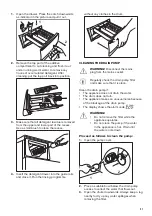
for all types of fabric, or special ones for
woollens only.
• Do not mix different types of detergents.
• To help the environment, do not use more than
the recommended quantity of detergent.
• Follow the instructions that you find on
packaging of the detergents or other treatments
without exceeding the indicated maximum level
(
).
• Use the recommended detergents for the type
and colour of the fabric, the programme
temperature and the level of soil.
ECOLOGICAL HINTS
• Set a programme without the prewash phase to
wash laundry with normal soil.
• Always start a washing programme with the
maximum load of laundry allowed.
• If you pre-treat the stains or use a stain remover,
set a programme with a low temperature.
• To use the correct quantity of detergent, check
the water hardness of your domestic system.
Refer to "Water hardness".
WATER HARDNESS
If the water hardness in your area is high or
moderate, we recommend that you use a water
softener for washing machines. In areas where the
water hardness is soft it is not necessary to use a
water softener.
To find out the water hardness in your area, contact
your local water authority.
Use the correct quantity of water softener. Follow
the instructions that you find on the packaging of
the product.
PREPARE THE DRYING CYCLE
• Open the water tap.
• Check if the drain hose is connected properly.
Refer to installation chapter for more
information.
• For the maximum laundry load of the drying
programmes, refer to the drying programmes
table.
ITEMS NOT SUITABLE FOR DRYING
Do not set a drying programme for this
laundry:
• Synthetic curtains.
• Pieces of clothing with metal inserts.
• Nylon stockings.
• Quilts.
• Bed covers.
• Duvets.
• Anoraks.
• Sleeping bags.
• Fabrics with residue of hair sprays, nail solvents
or similar.
• Garments with foam-rubber or materials similar
to foam-rubber.
GARMENT LABELS
When you dry the laundry, obey the indications on
the labels of the manufacturers:
•
= The item can be tumble dried
•
= The drying cycle is at high temperature
•
= The drying cycle is at reduced
temperature
•
= The item can not be tumble dried.
DRYING CYCLE DURATION
The drying time can change depending on:
• speed of the last spin
• dryness level
• type of laundry
• weight of the load
ADDITIONAL DRYING
If, at the end of the drying programme, the laundry
is still damp, set a short drying cycle again.
WARNING! To avoid creasing and
shrinkage do not overdry the
laundry.
GENERAL TIPS
Refer to the «Drying programmes» table to find the
average drying times.
Experience will help you to dry the laundry better.
Take note of the duration of the cycles done before.
To avoid the static charge at the end of the drying
cycle:
1. Use fabric conditioner in the washing cycle.
2. Use special fabric conditioner for tumble
dryers.
When the drying programme is completed remove
the laundry promptly.
29












































